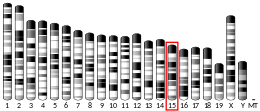EIF3S6
Eukaryotic translation initiation factor 3 subunit E (eIF3e) is a protein that in humans is encoded by the EIF3E gene.[5][6][7]
Interactions
EIF3S6 has been shown to interact with:
gollark: Wasn't me.
gollark: I split it up to do as much as possible in parallel and then stuck a simple dependency resolution thing on.
gollark: μhahaha, my website build script is now HIGHLY parallelized.
gollark: This would cost three (2) money.
gollark: It isn't parallelized as much as it could be.
References
- GRCh38: Ensembl release 89: ENSG00000104408 - Ensembl, May 2017
- GRCm38: Ensembl release 89: ENSMUSG00000022336 - Ensembl, May 2017
- "Human PubMed Reference:". National Center for Biotechnology Information, U.S. National Library of Medicine.
- "Mouse PubMed Reference:". National Center for Biotechnology Information, U.S. National Library of Medicine.
- Miyazaki S, Imatani A, Ballard L, Marchetti A, Buttitta F, Albertsen H, Nevanlinna HA, Gallahan D, Callahan R (1997). "The chromosome location of the human homolog of the mouse mammary tumor-associated gene INT6 and its status in human breast carcinomas". Genomics. 46 (1): 155–8. doi:10.1006/geno.1997.4996. PMID 9403073.
- Asano K, Merrick WC, Hershey JW (October 1997). "The translation initiation factor eIF3-p48 subunit is encoded by int-6, a site of frequent integration by the mouse mammary tumor virus genome". J. Biol. Chem. 272 (38): 23477–80. doi:10.1074/jbc.272.38.23477. PMID 9295280.
- "Entrez Gene: EIF3S6 Eukaryotic translation initiation factor 3, subunit 6 48kDa".
- Lehner B, Semple JI, Brown SE, Counsell D, Campbell RD, Sanderson CM (January 2004). "Analysis of a high-throughput yeast two-hybrid system and its use to predict the function of intracellular proteins encoded within the human MHC class III region". Genomics. 83 (1): 153–67. doi:10.1016/s0888-7543(03)00235-0. PMID 14667819.
- Hoareau Alves K, Bochard V, Réty S, Jalinot P (September 2002). "Association of the mammalian proto-oncoprotein Int-6 with the three protein complexes eIF3, COP9 signalosome and 26S proteasome". FEBS Lett. 527 (1–3): 15–21. doi:10.1016/s0014-5793(02)03147-2. PMID 12220626.
- Ewing RM, Chu P, Elisma F, Li H, Taylor P, Climie S, McBroom-Cerajewski L, Robinson MD, O'Connor L, Li M, Taylor R, Dharsee M, Ho Y, Heilbut A, Moore L, Zhang S, Ornatsky O, Bukhman YV, Ethier M, Sheng Y, Vasilescu J, Abu-Farha M, Lambert JP, Duewel HS, Stewart II, Kuehl B, Hogue K, Colwill K, Gladwish K, Muskat B, Kinach R, Adams SL, Moran MF, Morin GB, Topaloglou T, Figeys D (2007). "Large-scale mapping of human protein-protein interactions by mass spectrometry". Mol. Syst. Biol. 3: 89. doi:10.1038/msb4100134. PMC 1847948. PMID 17353931.
- Mayeur GL, Fraser CS, Peiretti F, Block KL, Hershey JW (October 2003). "Characterization of eIF3k: a newly discovered subunit of mammalian translation initiation factor elF3". Eur. J. Biochem. 270 (20): 4133–9. doi:10.1046/j.1432-1033.2003.03807.x. PMID 14519125.
- Morris-Desbois C, Réty S, Ferro M, Garin J, Jalinot P (December 2001). "The human protein HSPC021 interacts with Int-6 and is associated with eukaryotic translation initiation factor 3". J. Biol. Chem. 276 (49): 45988–95. doi:10.1074/jbc.M104966200. PMID 11590142.
- Morris-Desbois C, Bochard V, Reynaud C, Jalinot P (October 1999). "Interaction between the Ret finger protein and the Int-6 gene product and co-localisation into nuclear bodies". J. Cell Sci. 112 ( Pt 19): 3331–42. PMID 10504338.
Further reading
- Marchetti A, Buttitta F, Miyazaki S, Gallahan D, Smith GH, Callahan R (1995). "Int-6, a highly conserved, widely expressed gene, is mutated by mouse mammary tumor virus in mammary preneoplasia". J. Virol. 69 (3): 1932–8. PMC 188811. PMID 7853537.
- Desbois C, Rousset R, Bantignies F, Jalinot P (1996). "Exclusion of Int-6 from PML nuclear bodies by binding to the HTLV-I Tax oncoprotein". Science. 273 (5277): 951–3. Bibcode:1996Sci...273..951D. doi:10.1126/science.273.5277.951. PMID 8688078.
- Asano K, Kinzy TG, Merrick WC, Hershey JW (1997). "Conservation and diversity of eukaryotic translation initiation factor eIF3". J. Biol. Chem. 272 (2): 1101–9. doi:10.1074/jbc.272.2.1101. PMID 8995409.
- Méthot N, Rom E, Olsen H, Sonenberg N (1997). "The human homologue of the yeast Prt1 protein is an integral part of the eukaryotic initiation factor 3 complex and interacts with p170". J. Biol. Chem. 272 (2): 1110–6. doi:10.1074/jbc.272.2.1110. PMID 8995410.
- Block KL, Vornlocher HP, Hershey JW (1998). "Characterization of cDNAs encoding the p44 and p35 subunits of human translation initiation factor eIF3". J. Biol. Chem. 273 (48): 31901–8. doi:10.1074/jbc.273.48.31901. PMID 9822659.
- Guo J, Sen GC (2000). "Characterization of the interaction between the interferon-induced protein P56 and the Int6 protein encoded by a locus of insertion of the mouse mammary tumor virus". J. Virol. 74 (4): 1892–9. doi:10.1128/JVI.74.4.1892-1899.2000. PMC 111667. PMID 10644362.
- Guo J, Hui DJ, Merrick WC, Sen GC (2000). "A new pathway of translational regulation mediated by eukaryotic initiation factor 3". EMBO J. 19 (24): 6891–9. doi:10.1093/emboj/19.24.6891. PMC 305884. PMID 11118224.
- Yen HC, Chang EC (2000). "Yin6, a fission yeast Int6 homolog, complexes with Moe1 and plays a role in chromosome segregation". Proc. Natl. Acad. Sci. U.S.A. 97 (26): 14370–5. Bibcode:2000PNAS...9714370Y. doi:10.1073/pnas.97.26.14370. PMC 18925. PMID 11121040.
- Morris-Desbois C, Réty S, Ferro M, Garin J, Jalinot P (2001). "The human protein HSPC021 interacts with Int-6 and is associated with eukaryotic translation initiation factor 3". J. Biol. Chem. 276 (49): 45988–95. doi:10.1074/jbc.M104966200. PMID 11590142.
- Neuveut C, Jin DY, Semmes OJ, Diella F, Callahan R, Jeang KT (1997). "Divergent Subcellular Locations of HTLV-I Tax and Int-6: A Contrast between in vitro Protein-Protein Binding and Intracellular Protein Colocalization". J. Biomed. Sci. 4 (5): 229–234. doi:10.1007/BF02253422. PMID 12386384.
- Huang GJ, Zhang ZQ, Jin DY (2002). "Stimulation of IKK-gamma oligomerization by the human T-cell leukemia virus oncoprotein Tax". FEBS Lett. 531 (3): 494–8. doi:10.1016/S0014-5793(02)03590-1. PMID 12435599.
- Yen HC, Gordon C, Chang EC (2003). "Schizosaccharomyces pombe Int6 and Ras homologs regulate cell division and mitotic fidelity via the proteasome". Cell. 112 (2): 207–17. doi:10.1016/S0092-8674(03)00043-6. PMID 12553909.
- Watkins SJ, Norbury CJ (2004). "Cell cycle-related variation in subcellular localization of eIF3e/INT6 in human fibroblasts". Cell Prolif. 37 (2): 149–60. doi:10.1111/j.1365-2184.2004.00305.x. PMC 6495725. PMID 15030549.
This article is issued from Wikipedia. The text is licensed under Creative Commons - Attribution - Sharealike. Additional terms may apply for the media files.




